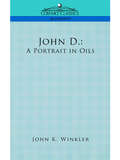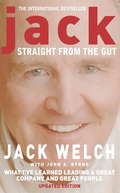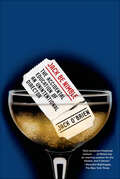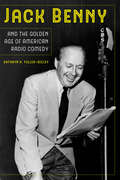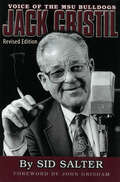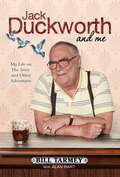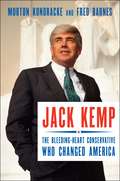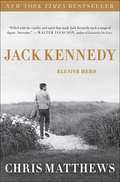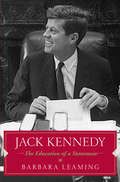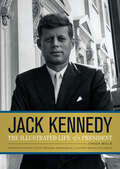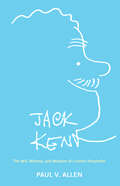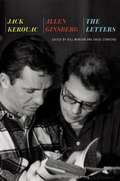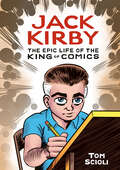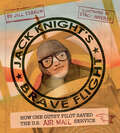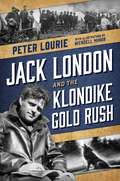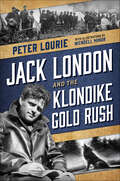- Table View
- List View
JLS: Forever and a Day
by JLSSince forming in 2007, JLS have achieved everything they'd hoped for and more. From four smash-hit albums and five number one singles, to BRIT and MOBO awards and sell-out tours, Oritsé, Marvin, JB, and Aston have proved themselves as one of Britain's biggest boybands ever. But all good things come to an end and in this, their last ever official book together, the boys share their favourite memories with the people they love most: their fans.Inside, they reflect on everything they've experienced in the last six years, as a band and in their own personal lives, while sharing exclusive photos and the secrets they've kept. Find out how they feel about juggling family and finding love with life on the road and recording in the studio; how special it feels to step out on stage in front of thousands of fans and why choosing to part from the best friends they could have ever found was the hardest decision of all.The highs, the lows; the good times and bad, this is JLS like you've never seen them before. Older, wiser and hotter than ever, this is their final farewell and a treasured keepsake for years to come.
JOHN D. ROCKEFELLER: A Portrait in Oils
by John K. WinklerWhat was the world's first billionaire really like? This highly entertaining work, by an acclaimed business biographer, seeks to explode the "shadowy myth" of John D. Rockefeller and reveal the "rare and astonishing personality" behind it. From his humble roots in Ohio, where he learned thrift and industry as the bookkeeper of a dockside warehouse, to the death threats this "modern Machiavelli" received during the early years of Standard Oil, to his ascendancy to the rank of "the most detested man in the country"-when churches refused his donations as tainted money-and his subsequent formation of the philanthropic Rockefeller Foundation, this is a knowingly ironic and subtly witty work of biography.
Jacinda Ardern: Leading with Empathy
by Supriya Vani Carl A. HarteJacinda Ardern was swept to office in 2017 on a wave of popular enthusiasm dubbed &‘Jacindamania&’. In less than three months, she rose from deputy leader of the opposition to New Zealand&’s highest office. Her victory seemed heroic. Few in politics would have believed it possible; fewer still would have guessed at her resolve and compassionate leadership, which, in the wake of the horrific Christchurch mosque shootings of March 2019, brought her international acclaim. Since then, her decisive handling of the COVID-19 pandemic has seen her worldwide standing rise to the point where she is now celebrated as a model leader. In 2020 she won an historic, landslide victory and yet, characteristically, chose to govern in coalition with the Green Party. Jacinda Ardern: Leading with Empathy carefully explores the influences – personal, social, political and emotional – that have shaped Ardern. Peace activist and journalist Supriya Vani and writer Carl A. Harte build their narrative through Vani&’s exclusive interviews with Ardern, as well as the prime minister&’s public statements and speeches and the words of those who know her. We visit the places, meet the people and understand the events that propelled the daughter of a small-town Mormon policeman to become a committed social democrat, a passionate Labour Party politician and a modern leader admired for her empathy and courage.
Jack
by Jack WelchJack Welch was perhaps the greatest corporate leader of the 20th century. When he first became CEO of General Electric in 1981 the company was worth $12 billion. Twenty years later it is worth a total of $280 billion. But Welch was more than just the leader of the most successful business in the world. He revolutionised GE's entire corporate culture with his distinctive, highly personal management style: the individual appreciation of each of his 500 managers, the commitment to an informal but driven work style and the encouragement of candour were all part of the Welch approach. Following John Harvey Jones's Making it Happen and Troubleshooter, Jack has already become the businessman's bible for the 21st century - an inspiration for a new generation of corporate players.
Jack & Jack: You Don't Know Jacks
by Jack & JackVine royalty, YouTube megastars, hip-pop sensations, and best friends, Jack & Jack bring their own brand of irreverent comedy, on-point style, and heartfelt life advice to You Don't Know Jacks.Jack & Jack: You Don't Know Jacks is a 240-page, full-colour behind-the-scenes look at the lives of Jack Gilinsky and Jack Johnson, two of the hottest stars performing today. The book details the rise of two best friends growing up in Nebraska, posting Nerd Vandals Vines, to becoming iTunes bestselling rap-rock stars. Full of exclusive photographs, backstage antics, and hilarious anecdotes, it's perfect for any fan who's ever dreamed of someday being famous.
Jack & Jack: You Don't Know Jacks
by Jack Gilinsky Jack JohnsonVine ingenues, YouTube megastars, hip-pop sensations, and best friends Jack & Jack bring their own brand of irreverent comedy, on-point style, and heartfelt life advice to You Don’t Know Jacks. Nebraska natives Jack Gilinsky and Jack Johnson shot to instant fame after their first Vine, “Nerd Vandals,” was dubbed “a perfect Vine” by the Huffington Post. It’s been looped more than ten million times since—and that Vine was just the beginning.Now, after a number one hit on iTunes, nearly two million singles sold, live performances where they have shared the stage with Demi Lovato, Shawn Mendes, and Fifth Harmony, and over 26 million followers across all their social media channels, Jack & Jack are on a wild ride—and they’re not planning to slow down anytime soon. Fans will love reading about their journey from being two regular kids growing up in Omaha, Nebraska, to global superstardom. Complete with never-before-seen photos, behind-the-scenes stories, and hilarious personal anecdotes, You Don’t Know Jacks is an insider look at the lives of Jack & Jack, as told by the guys themselves.
Jack Be Nimble: The Accidental Education of an Unintentional Director
by Jack O'BrienA warm, witty tell-all and history of American regional theater, from one of our best-loved directorsFor Jack O'Brien, there's nothing like a first encounter with a great performer, nothing like the sound of an audience bursting into applause. In short, there's nothing like the theater. Following a fairly normal Midwestern childhood, O'Brien hoped to make his mark by writing lyrics for Broadway but was instead pulled into the growing American regional theater movement by the likes of John Houseman, Helen Hayes, Ellis Rabb, and Eva Le Gallienne. He didn't intend to become a director, or to direct some of the most brilliant—and sometimes maddening—personalities of the age, but in a charming, hilarious, and unexpected way, that's what happened. O'Brien has had a long, successful career on Broadway and as artistic director of San Diego's Old Globe Theatre, but the history of the movement that shaped him has been overlooked. In the middle of the last century, some extraordinary people forged a link in the chain connecting European influences such as the Moscow Art Theatre and Great Britain's National Theatre with the flourishing American theater of today. O'Brien was there to see and record it all, in beautifully vivid detail. Funny, exuberant, unfailingly honest, Jack Be Nimble is the tale of those missing heroes, performances, and cultural battles. It is also the irresistible story of one of our best-loved theater directors, growing into his passion and discovering what he is capable of.
Jack Benny
by Mary Livingstone Benny Hilliard Marks Marcia BorieA biography of the famous comedian by his wife.
Jack Benny and the Golden Age of American Radio Comedy
by Kathryn H. Fuller-SeeleyThe king of radio comedy from the Great Depression through the early 1950s, Jack Benny was one of the most influential entertainers in twentieth-century America. A master of comic timing and an innovative producer, Benny, with his radio writers, developed a weekly situation comedy to meet radio’s endless need for new material, at the same time integrating advertising into the show’s humor. Through the character of the vain, cheap everyman, Benny created a fall guy, whose frustrated struggles with his employees addressed midcentury America’s concerns with race, gender, commercialism, and sexual identity. Kathryn H. Fuller-Seeley contextualizes her analysis of Jack Benny and his entourage with thoughtful insight into the intersections of competing entertainment industries and provides plenty of evidence that transmedia stardom, branded entertainment, and virality are not new phenomena but current iterations of key aspects in American commercial cultural history.
Jack Benny: An Intimate Biography
by Irving A. FeinFein joined Benny in 1947 as publicity and advertising director of his company, which was sold to CBS. Fein then became executive producer of Benny's programs, winning an Emmy in 1961.
Jack Benny: The Radio and Television Work
by The Editors at the Museum of Television and RadioDetailed descriptions of over 150 radio and TV programs, a section on his historic 'radio feud' with Fred Allen, reprints of scripts, and critical analyses of his work by the curators of the museum.
Jack Cristil: The Voice of the MSU Bulldogs
by Sid SalterThis is the biography of Jack Cristil. Sid Salter takes us through the life of Jack Cristil, the radio sportscaster for Mississippi State University football and basketball for 58 years. It is an interesting look at the broadcasting microphone throughout those years.
Jack Cristil: Voice of the MSU Bulldogs, Revised Edition
by Sid SalterJack Cristil (1925-2014) was a Southeastern Conference icon and the Voice of Bulldog athletics for more than five decades. In this biography, Cristil's remarkable life and career is shared with all Bulldog fans. Authored by Mississippi journalist Sid Salter with a foreword by distinguished Mississippi State University alum John Grisham, the book originally sold over 10,000 copies and raised over $170,000 for the Jacob S. "Jack" Cristil Scholarship in Journalism at MSU.With a fifty-eight-year association with MSU, Cristil was the second-longest tenured college radio play-by-play announcer in the nation at the time of his 2011 retirement. During his legendary career as the Voice of the Bulldogs, Cristil called 636 football games since 1953. That's roughly 60 percent of all the football games played in school history. He was in his 54th season as the men's basketball play-by-play voice, having described the action of almost 55 percent of all the men's basketball games. In all, Cristil shared with Bulldog fans across the Magnolia State and around the world more than 1,500 collegiate contests. Central to Cristil's inspiring story was his upbringing in Memphis as the son of first-generation Russian-Jewish immigrants. This paperback edition is updated with new material covering Cristil's death and memorial service, with additional post-retirement and memorial photos.
Jack Daniel's Legacy
by Ben A. GreenLynchburg is famous for whiskey... Jack Daniel Whiskey. But who was this little man? And how did he come to make the finest whiskey in the world? Here's his story: In the rolling hills of Moore County, Tennessee, you will find The Jack Daniel's Distillery. It has been in existence for over 125 years. The area was originally part of Lincoln County where Jasper Newton Daniel (later called "Jack") was born on September 5, 1846, the youngest of 10 children. Jack's mother died when he was just a baby. Several years later his father remarried. Jack never got along with his stepmother and left home at the age of 6 to live with a nearby uncle. As a young boy he was befriended by Dan Call a local minister and storekeeper. He took Jack under his wing and trained him to work in the store. But Jack was not happy working there. He had a keen interest in the "still house" which was located on the property. Making whiskey at that time in that area was an acceptable practice though it was never consumed on Sundays. Dan promised Jack he could come to the still house whenever he wanted and he would teach him the art of making the world's best whiskey... made the Lincoln County way. In 1861, the war came to Lincoln County. Jack was too young to serve so remained as an apprentice to Dan Call, learning the sour mash method and perfecting the unique method known as the "Lincoln County Process." In 1863 after hearing a fiery sermon on the evils of alcohol, Dan Call's wife, along with their entire congregation, called on Dan to make "a serious decision regarding being a minister and operating a distillery." Rev. Call decided to sell his business to his young apprentice, Jack Daniel. Upon hearing of the availability of a particular piece of land near Lynchburg, Jack moved his operation there. This area contained the perfect situation for brewing excellent quality whiskey: the pure spring water from the limestone cave and the sugar maple trees that grew in abundance nearby. The War Between the States was over and Jack realized the Federal government would soon be taxing his products. Thinking ahead, Jack at the age of 16, took the step of being the first distillery to register with the United States government. You will see to this day the words "Oldest registered distillery in the US" on every Jack Daniel's label. The secret of the Lincoln County Process is based on the tedious filtering of the whiskey through charcoal produced by the sugar maple tree and, of course, the wonderful pure spring water. No chemicals are used in this natural fermentation process. In 1904 Jack secretly entered his brew in the St. Louis World's Fair. He completed with older, more established products from Europe. Amazingly, he won the Gold Medal for the Best Whiskey in the World! In 1905 he won another prestigious award in Belgium. He now had customers around the world and Jack Daniel Whiskey was famous! He continued running the successful business until a freak accident ended it all. One day, in frustration, he kicked a safe in his office, which wouldn't open and crushed his toe. It later became gangrenous and his health declined during the next 6 years leading to his death in 1911. Jack Daniel never married and had no children. He left the distillery to his nephew, Lem Motlow. Lem expanded the business and it was then handed on to his sons. Though the company was sold in 1956, the Motlow Family is still majority owner and continues to operate and manage the company. All these years the distillery has never suspended operations and to this day it is located in a "dry" county. You can't buy whiskey for consumption in Lincoln County. However, Miss Mary BoBo's Boarding House always serves a dish containing the local hometown "product" at every meal.
Jack Duckworth and Me
by Bill TarmeyActor Bill Tarmey first appeared as Jack Duckworth in Coronation Street in November 1979, when his formidable on-screen wife Vera dragged him to Brian and Gail Tilsley's wedding, only to have him sneak off for a pint at the first opportunity. After playing what is arguably the nation's best-loved soap character for 31 years, Bill leaves the series in December 2010. To coincide with this momentous event in soap history, Bill now tells the full story of what it has been like to play this loveable rogue for almost half his life. He reveals the hilarious on-set japes behind the scenes - such as getting fits of the giggles with Curly Watts and Alec Gilroy, what it was like playing the Romeo to Bet Lynch and Dulcie Froggat, plus the more emotional times such as when Bernard Youens, who played Stan Ogden, died. There is also the fascinating story of Bill's early years growing up in the streets of post-war Manchester, with bombsites for playgrounds and an ex-Navy grandpa who taught him how to box. Destined to become a master asphalter like his Dad, Bill never gave up his love of singing, and by the late 1960s he had made a name for himself in the unforgiving environment of the Working Men's Club circuit. Taking work as a TV extra, Bill soon found himself treading the famous cobbled streets, and was a natural in his newly created role of Jack, which has been uncanny in mirroring Bill's own life for its lurches of fortune. Packed with anecdotes to delight both Corrie fans and lovers of British TV everywhere, this warm-hearted and substantial autobiography is THE soap star memoir the country has been waiting for. They will not be disappointed.
Jack Kemp
by Morton Kondracke Fred BarnesThe definitive biography of Jack Kemp, and why his legacy matters to today's GOP.As today's Republicans struggle to broaden their base and promote reform, some are reviving the legacy of Jack Kemp, one of the most important Republicans of the 1970s, 80s, and 90s.Kemp approached politics the same way he played quarterback for the Bills: with a refusal to accept defeat. Yet he was also willing to compromise to get things done, and his commitment to the working class and minorities attracted voters who usually rejected the GOP. He was instrumental in helping Ronald Reagan create an era of sustained and widespread prosperity.Drawing on never-published papers and the Kemp oral history project, noted journalists Morton Kondracke and Fred Barnes trace Kemp's whole life, from his childhood through his pro football career to his unusually influential years as congressman and cabinet secretary. Despite many ups and downs, including failed presidential and vice presidential bids, Kemp proved that a "bleeding-heart conservative" could redefine what was possible in American politics.From the Hardcover edition.
Jack Kennedy: Elusive Hero
by Chris Matthews"What was he like?"Jack Kennedy said the reason people read biography is to answer that basic question. With the verve of a novelist, Chris Matthews gives us just that. We see this most beloved president in the company of friends. We see and feel him close-up, having fun and giving off that restlessness of his. We watch him navigate his life from privileged, rebellious youth to gutsy American president. We witness his bravery in war and selfless rescue of his PT boat crew. We watch JFK as a young politician learning to play hardball and watch him grow into the leader who averts a nuclear war.What was he like, this person whose own wife called him "that elusive, unforgettable man"? The Jack Kennedy you discover here wanted never to be alone, never to be bored. He loved courage, hated war, lived each day as if it were his last.Chris Matthews's extraordinary biography is based on personal interviews with those closest to JFK, oral histories by top political aide Kenneth O'Donnell and others, documents from his years as a student at Choate, and notes from Jacqueline Kennedy's first interview after Dallas. You'll learn the origins of his inaugural call to "Ask what you can do for your country." You'll discover his role in the genesis of the Peace Corps, his stand on civil rights, his push to put a man on the moon, his ban on nuclear arms testing. You'll get, more than ever before, to the root of the man, including the unsettling aspects of his personal life. As Matthews writes, "I found a fighting prince never free of pain, never far from trouble, never accepting the world he found, never wanting to be his father's son. He was a far greater hero than he ever wished us to know."
Jack Kennedy: The Education of a Statesman
by Barbara Leaming"An absorbing and enjoyable book."--New York Times Book Review Drawing on new primary sources, this biography is the first to detail the influence of British history, literature, and culture--in particular, the ideas of Winston Churchill--on America's thirty-fifth president. For the first time we trace the friendships and forces that led to the White House and shaped Kennedy's actions there. In this intimate portrait of a leader torn between politics and principle, we finally come to know the man Kennedy wanted to be and to understand his long, private struggle to become that man.
Jack Kennedy: The Illustrated Life of a President
by Chuck WillsThe presidential scholar shares an intimate visual biography of JFK through personal photos, diary entries, and other rare memorabilia. Until his inspiring life was tragically cut short, John F. Kennedy commanded the world’s attention. Today, his legacy is still very much alive. In this fascinating volume, Chuck Wills presents an inspiring and uniquely personal chronicle of the president’s life. Jack Kennedy includes everything from doodles and diary entries to drafts of major addresses. Hundreds of photographs and a compelling narrative uncover the remarkable tale of an intensely private man, from his rivalry with his older brother and his persistent courtship of Jackie to the inner workings of a historical presidency.
Jack Kent: The Wit, Whimsy, and Wisdom of a Comic Storyteller
by Paul V. AllenJack Kent (1920–1985) had two distinct and successful careers: newspaper cartoonist and author of children’s books. For each of these he drew upon different aspects of his personality and life experiences. From 1950 to 1965 he wrote and drew King Aroo, a nationally syndicated comic strip beloved by fans for its combination of absurdity, fantasy, wordplay, and wit. The strip’s DNA was comprised of things Kent loved—fairytales, nursery rhymes, vaudeville, Krazy Kat, foreign languages, and puns. In 1968, he published his first children’s book, Just Only John, and began a career in kids’ books that would result in over sixty published works, among them such classics as The Fat Cat and There’s No Such Thing as a Dragon. Kent’s stories for children were funny but often arose from the dark parts of his life—an itinerant childhood, an unfinished education, two harrowing tours of duty in World War II, and a persistent lack of confidence—and tackled such themes as rejection, isolation, self-doubt, and the desire for transformation.Jack Kent: The Wit, Whimsy, and Wisdom of a Comic Storyteller illuminates how Kent’s life experiences informed his art and his storytelling in both King Aroo and his children’s books. Paul V. Allen draws from archival research, brand-new interviews, and in-depth examinations of Kent’s work. Also included are many King Aroo comic strips that have never been reprinted in book form.
Jack Kerouac and Allen Ginsberg
by Jack Kerouac Allen GinsbergThe first collection of letters between the two leading figures of the Beat movement Writers and cultural icons Jack Kerouac and Allen Ginsberg are the most celebrated names of the Beat Generation, linked together not only by their shared artistic sensibility but also by a deep and abiding friendship, one that colored their lives and greatly influenced their writing. <P><P>Editors Bill Morgan and David Stanford shed new light on this intimate and influential friendship in this fascinating exchange of letters between Kerouac and Ginsberg, two thirds of which have never been published before. <P><P>Commencing in 1944 while Ginsberg was a student at Columbia University and continuing until shortly before Kerouac's death in 1969, the two hundred letters included in this book provide astonishing insight into their lives and their writing. While not always in agreement, Ginsberg and Kerouac inspired each other spiritually and creatively, and their letters became a vital workshop for their art. <P><P>Vivid, engaging, and enthralling, Jack Kerouac and Allen Ginsberg: The Letters provides an unparalleled portrait of the two men who led the cultural and artistic movement that defined their generation. .
Jack Kirby: The Epic Life of the King of Comics [A Graphic Biography]
by Tom ScioliTold in vivid graphic novel form by a groundbreaking Eisner-nominated comics creator, the long-overdue biography of the legend who co-created Captain America, Iron Man, Black Panther, the Fantastic Four, the X-Men, and many more superhero favorites.&“A fast-paced celebration of an underheralded legend within the comic-book industry.&”—Kirkus ReviewsNAMED ONE OF THE BEST BOOKS OF THE YEAR BY LIBRARY JOURNALThis sweeping, full-color comic book biography tells the complete life story of Jack Kirby, co-creator of some of the most enduring superheroes and villains of the twentieth century for Marvel Comics, DC Comics, and more. Critically acclaimed graphic novelist Tom Scioli breathes visual life into Kirby's life story--from his days growing up in New York during the Great Depression and discovering a love for science fiction and cartoons to his time on the frontlines in the European theatre of World War II where he experienced the type of action and adventure he'd later imbue his comic pages with, and on to his world-changing collaborations at Marvel with Stan Lee, where the pair redefined comics as a part of pop culture.Just as every great superhero needs a villain to overcome, Kirby's story also includes his struggles to receive the recognition and compensation that he believed his work deserved. Scioli captures his moves from Marvel to DC and back again, showing how Kirby himself and later his family fought to preserve his artistic legacy.Drawn from an unparalleled imagination and a life as exciting as his comic book tales, Kirby's super-creations have influenced subsequent generations of creatives in the comics field and beyond. Now, readers can experience the life and times of a comics titan through the medium that made him famous.
Jack Knight's Brave Flight: How One Gutsy Pilot Saved the US Air Mail Service
by Jill EsbaumHigh-flying history is brought to life in this suspenseful story of an unknown and daring pilot named Jack Knight, who in 1921 flew his biplane straight into a blizzard over America's heartland and saved the US Air Mail Service in the process.When Jack Knight takes off in his biplane from North Platte, Nebraska, in 1921, hundreds of people crowd the airstrip. Is Jack transporting a famous passenger? Is he ferrying medicine for a sick child? Nope--Jack has six sacks of mail. For the past few years, biplanes like Jack's have been flying the mail only during daylight hours. Flying after dark is risky and crashes are too common, so lawmakers decide to cut funding for the US Air Mail Service. Outraged officials and pilots want to prove that flying the mail is best, so they concoct a plan--a coast-to-coast race. But when a crash, exhaustion, and a snowstorm ground three of the planes, Jack Knight becomes the race's only hope. All he has to do is fly all night long, leaning out of the plane to see, and navigate a blizzard over land he's never covered with an empty fuel tank. Will Jack pull it off and save the Air Mail Service?
Jack London And The Klondike Gold Rush
by Wendell Minor Peter LourieSwept up in the Gold Rush of 1897, young Jack London headed north to strike it rich in the Klondike and discovered something more precious than gold—the seeds of the stories that would flower into his classic novels The Call of the Wild and White Fang, and timeless short stories such as "To Build A Fire." This gripping tale follows London as he treks up the ruthless Chilkoot Trail, braves the lethal Whitehorse Rapids, survives a bad case of scurvy, and conquers many more dangers of the Yukon during his quest for gold.
Jack London and the Klondike Gold Rush
by Peter LourieHere is a compelling middle grade nonfiction tale of how one classic writer drew upon a rugged life of adventure to create works of literature, punctuated by stunning black-and-white art by Wendell Minor and illustrative photographic material.Swept up in the Gold Rush of 1897, young Jack London headed north to strike it rich in the Klondike and discovered something more precious than gold—the seeds of the stories that would flower into his classic novels The Call of the Wild and White Fang, and timeless short stories such as "To Build A Fire." This gripping tale follows London as he treks up the ruthless Chilkoot Trail, braves the lethal Whitehorse Rapids, survives a bad case of scurvy, and conquers many more dangers of the Yukon during his quest for gold. A Christy Ottaviano Book

